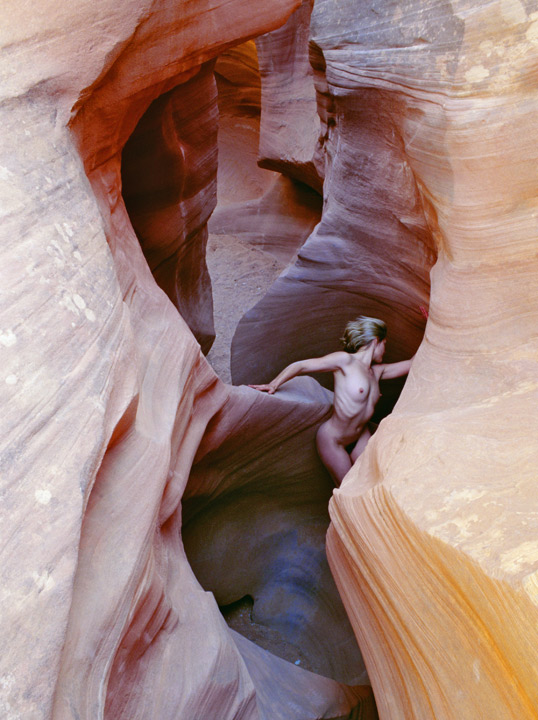

“Elements” is another image from the Grand Staircase-Escalante National Monument area in Utah. We have already visited the Dry Fork of Coyote Gulch and the narrows there. There are several slot canyons that open into Coyote Gulch, the first is Peek-a-boo Gulch, then Spooky Gulch, and last Brimstone Gulch. These all drain into Lake Powell eventually and are dry washes most of the time. “Elements” is a study in repeating natural curves with the flowing lines of the canyon merging into the human ribs and molten hair, reminding us that we, like the polished rock, are natures sculptured masterpieces. This image also is a good one to talk more about lens selection and F-stop use in designing a photograph. You can see the lines of the canyon remaining sharp in the foreground. I was recently at a meeting in a hotel in Park City that had a large landscape picture on the wall with a background of mountains and flowers in the foreground. The picture was nice, but the flowers were out of focus, weakening the image. So–how do you make sure this does not happen to your pictures? First, you MUST not use the programed mode on your camera and here is why. To have everything in focus from close to the lens to infinity you must do one of two things, either use a wide angle lens so the near focal point is close to your lens, or use a very small lens opening on a regular lens ( large F-stop) to get the maximum depth of field so everything stays in focus. If you leave your camera on the program mode, the low light in the canyon will cause the camera to open the lens to let in more light, decreasing the depth of field and blurring the close objects. If you use a wide angle lens, this will keep things in focus, but distort the image, making close objects look far away. If you use a regular lens and use an F-stop of –say 22–this will give a great depth of field, but require a long exposure time, because it lets less light in. Start by visualizing how you want the image to look, then select a lens for this and place your camera on a tripod. Set your camera on either aperture priority or manual mode and set it at the highest F-stop (smallest aperture) for your lens, and set your lens on the infinity setting for maximum depth of field. Get your exposure from your camera meter or a hand held meter for a proper exposure time. You can also adjust the ISO setting on your digital camera or use a high speed film for low light. Now for the final setting–hyperfocal selection. Look through the view finder at the nearest object and back the lens setting away from infinity slowly until the nearest item is in focus and then hit the shutter–and you will find that all the picture is now in focus. I will show many more examples of selective focus with planned blurring of elements, but most nature shots look best without camera movement or blurring. P. Miller www.humanlandscapes.com
Buy Now